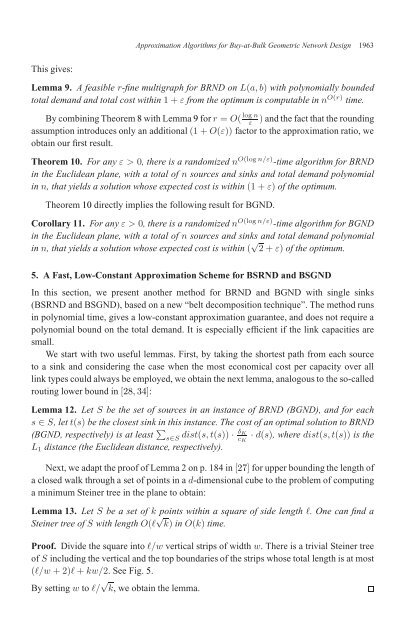Approximation Algorithms for Buy-at-Bulk Geometric Network Design
Approximation Algorithms for Buy-at-Bulk Geometric Network Design
Approximation Algorithms for Buy-at-Bulk Geometric Network Design
Create successful ePaper yourself
Turn your PDF publications into a flip-book with our unique Google optimized e-Paper software.
<strong>Approxim<strong>at</strong>ion</strong> <strong>Algorithms</strong> <strong>for</strong> <strong>Buy</strong>-<strong>at</strong>-<strong>Bulk</strong> <strong>Geometric</strong> <strong>Network</strong> <strong>Design</strong> 1963This gives:Lemma 9. A feasible r-fine multigraph <strong>for</strong> BRND on L(a,b) with polynomially boundedtotal demand and total cost within 1+εfrom the optimum is computable inn O(r) time.By combining Theorem 8 with Lemma 9 <strong>for</strong>r = O( lognε) and the fact th<strong>at</strong> the roundingassumption introduces only an additional(1+O(ε)) factor to the approxim<strong>at</strong>ion r<strong>at</strong>io, weobtain our first result.Theorem 10. For any ε > 0, there is a randomized n O(logn/ε) -time algorithm <strong>for</strong> BRNDin the Euclidean plane, with a total of n sources and sinks and total demand polynomialinn, th<strong>at</strong> yields a solution whose expected cost is within(1+ε) of the optimum.Theorem 10 directly implies the following result <strong>for</strong> BGND.Corollary 11. For anyε > 0, there is a randomizedn O(logn/ε) -time algorithm <strong>for</strong> BGNDin the Euclidean plane, with a total of n sources and sinks and total demand polynomialinn, th<strong>at</strong> yields a solution whose expected cost is within( √ 2+ε) of the optimum.5. A Fast, Low-Constant <strong>Approxim<strong>at</strong>ion</strong> Scheme <strong>for</strong> BSRND and BSGNDIn this section, we present another method <strong>for</strong> BRND and BGND with single sinks(BSRND and BSGND), based on a new “belt decomposition technique”. The method runsin polynomial time, gives a low-constant approxim<strong>at</strong>ion guarantee, and does not require apolynomial bound on the total demand. It is especially efficient if the link capacities aresmall.We start with two useful lemmas. First, by taking the shortest p<strong>at</strong>h from each sourceto a sink and considering the case when the most economical cost per capacity over alllink types could always be employed, we obtain the next lemma, analogous to the so-calledrouting lower bound in[28,34]:Lemma 12. Let S be the set of sources in an instance of BRND (BGND), and <strong>for</strong> eachs ∈ S, lett(s) be the closest sink in this instance. The cost of an optimal solution to BRND(BGND, respectively) is <strong>at</strong> least ∑ δKs∈Sdist(s,t(s)) ·c K· d(s), where dist(s,t(s)) is theL 1 distance (the Euclidean distance, respectively).Next, we adapt the proof of Lemma 2 on p. 184 in[27] <strong>for</strong> upper bounding the length ofa closed walk through a set of points in ad-dimensional cube to the problem of computinga minimum Steiner tree in the plane to obtain:Lemma 13. Let S be a set of k points within a square of side length l. One can find aSteiner tree ofS with lengthO(l √ k) in O(k) time.Proof. Divide the square intol/w vertical strips of width w. There is a trivial Steiner treeofS including the vertical and the top boundaries of the strips whose total length is <strong>at</strong> most(l/w+2)l+kw/2. See Fig. 5.By settingw to l/ √ k, we obtain the lemma.
















